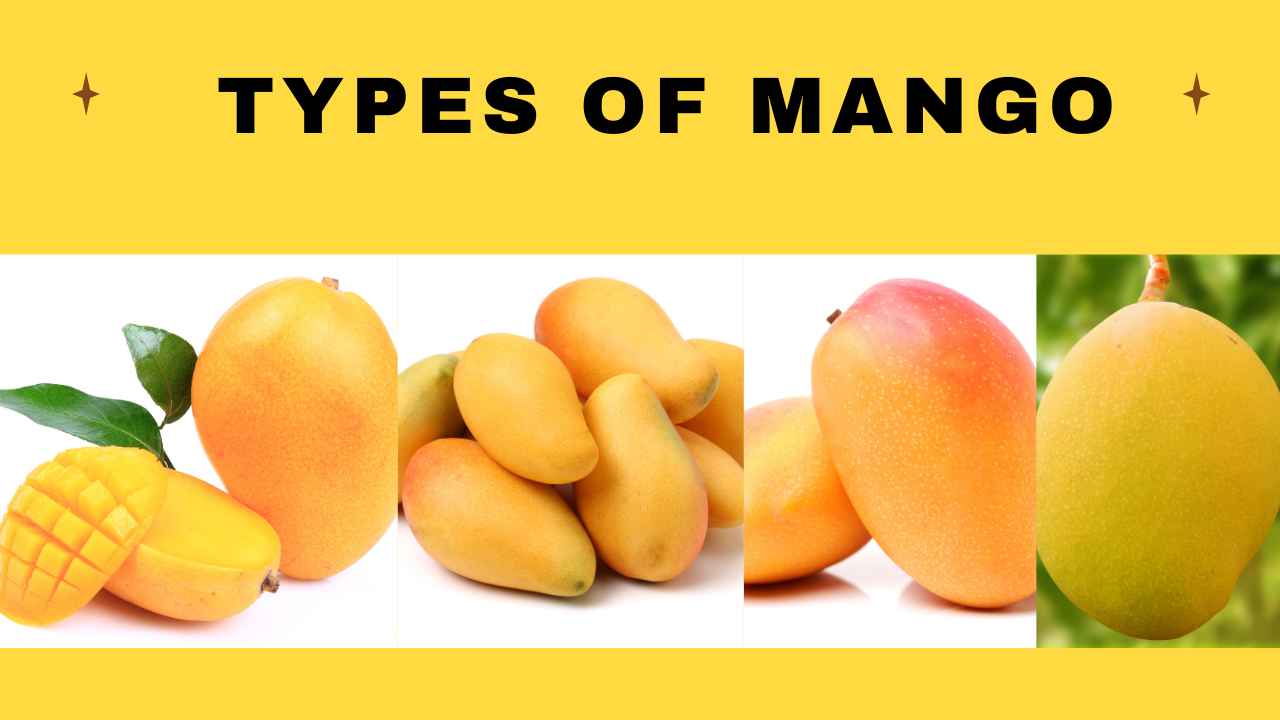Mango is undoubtedly the king of fruits, and rightly so. Its sweet, juicy, and delectable taste makes it an absolute favorite among fruit lovers.
Mangoes are not just delicious, but they are also rich in vitamins, minerals, and antioxidants that are essential for our health. [1]
At present, there are over 1000 varieties of mangoes available across the world, each with its unique flavor, texture, and aroma.
In this article, we will take a closer look at some of the 34 mango varieties that you should try at least once in your lifetime.
Types of Mango
1: Dasheri Mango
The Dasheri mangoes are grown and harvested over an extended growing season, with the harvesting period spanning from May to August. Once the mangoes ripen, they display a light yellow-green hue with peachy flesh that is visually appealing.
Dasheri mangoes emit a fragrant and aromatic scent that indicates their natural juiciness. They are widely cherished as one of the most popular summer fruits in their native regions of northern India, Nepal, and Pakistan. [2]
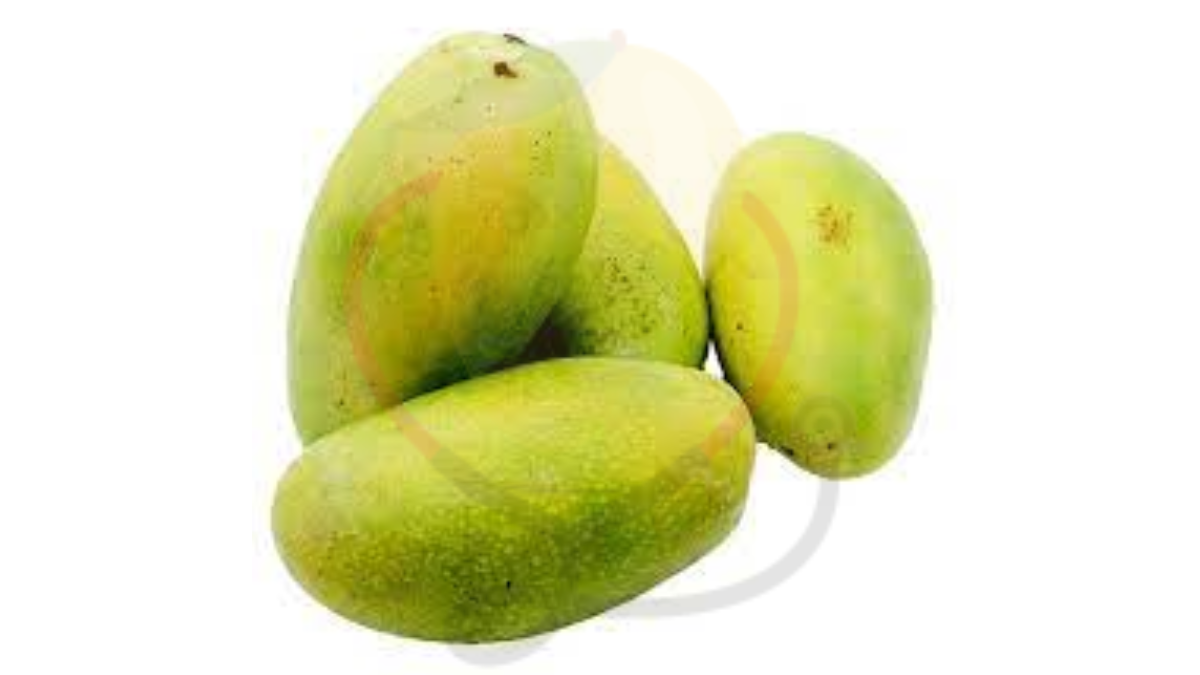
Nutritional Values
- Calories: 135
- Carbohydrates: 35g (12%)
- Fiber: 3g (12%)
- Protein: 1.06g (2%)
- Fat: 0.45g (1%)
- Vitamin C: 45.7mg (51%)
- Vitamin A: 1262IU (42%)
- Calcium: 20mg (2%)
- Iron: 0.28mg (3%)
Health Benefits
1: Boosts Immunity
The high Vitamin C content in Dasheri mango helps to boost the immune system, protecting the body against infections and diseases. [3]
2: Improves Digestion
The fiber content in Dasheri mango helps to improve digestion and prevent constipation, which is beneficial for maintaining a healthy digestive system.
3: Helps to maintain healthy skin
The Vitamin A content in Dasheri mango helps to maintain healthy skin, promoting cell growth and preventing premature aging.
4: Reduces the risk of cancer
The antioxidants present in Dasheri mango help to protect the body against damage from free radicals, reducing the risk of cancer.
5: Lowers Cholesterol
The fiber content in Dasheri mango helps to lower cholesterol levels in the body, reducing the risk of heart disease.
2: Neelam Mango
No conversation about mangoes is complete without mentioning the Neelam mango. This variety is considered to be a delicacy and is widely grown in India. What makes Neelam mangoes so unique is their subtle acidity, which is most prominent when they are harvested just before they are fully ripe. [4]

3: Chaunsa Mango
These mangoes are a small family of Indian cultivars that includes white Chaunsa; honey Chaunsa, and sweet Chaunsa. Chaunsa mangoes are highly regarded in India for their pale yellow skin with a light red blush exterior. Once cut open, the flesh of the mangoes is soft, creamy, and incredibly sweet, owing to the abundance of natural fruit sugars they contain. Chaunsa mango is often used to make desserts, smoothies, and mango juice. [5]
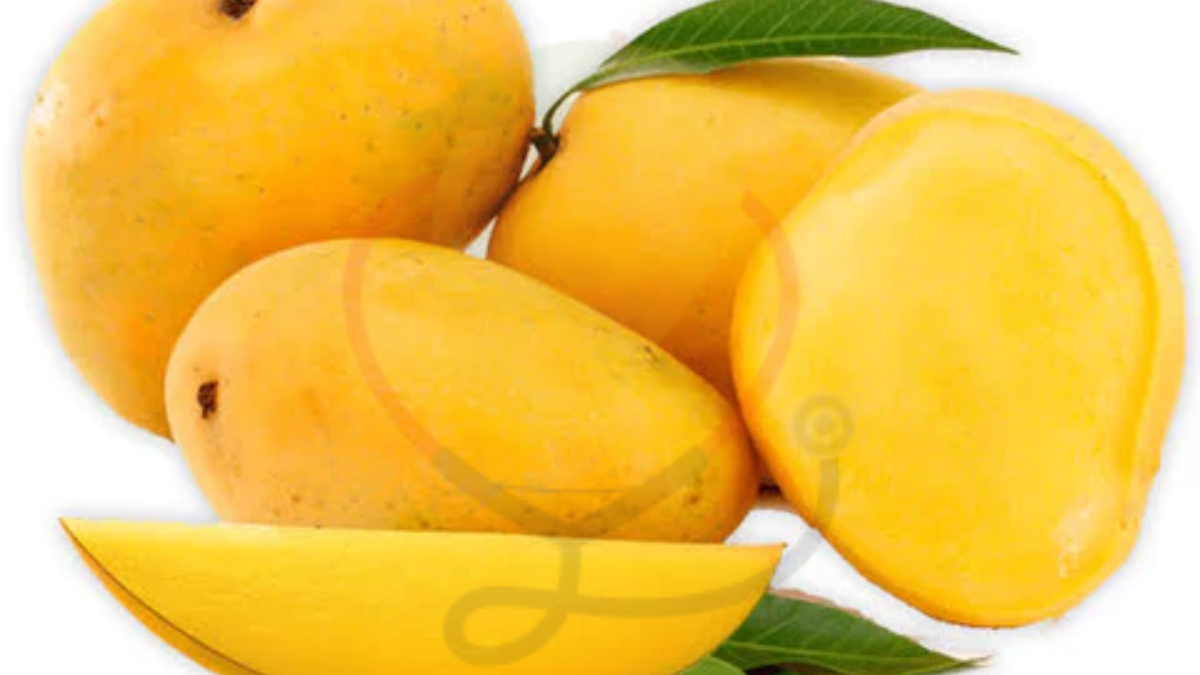
Chaunsa Mango Nutrition
- Calories: 65
- Carbohydrates: 17 g
- Protein: 0.5 g
- Fat: 0.3 g
- Fiber: 1.8 g
- Vitamin C: 36.4 mg (61% of the Daily Value)
- Vitamin A: 1,740 IU (35% of the Daily Value)
- Folate: 14 mcg (4% of the Daily Value)
- Potassium: 156 mg (4% of the Daily Value)
4: Sindhri Mangoes
Sindhri mangoes are a popular variety in Pakistan, known for their large, oval shape, greenish-yellow skin, and pinkish-red flesh. [6] These mangoes have a sweet and pleasant taste, with a slight hint of tartness.

They are commonly enjoyed fresh or used in various mango-based desserts and condiments like aam chutney. Sindhri mangoes originate from the town of the same name in the Mirpur Khas District and may have a slightly acidic taste at the beginning of the season.
Sindhri Mangoes Nutrition
- Vitamin C: 67%
- Vitamin A: 18%
- Folate: 11%
- Vitamin K: 8%
- Potassium: 6%
- Copper: 4%
- Vitamin B6: 4%
- Vitamin E: 3%
- Magnesium: 3%
5: Langra Mango
Compared to other mango varieties like Langra, Sindhri mangoes have a longer shelf life and are less likely to spoil quickly. This is especially true near the end of the season between May and August when they are available in larger sizes. [7]
Langra mango is a sweet and juicy fruit commonly used in Indian cuisine. It is believed to have originated in Varanasi, India, and is named after the disabled man who owned the tree.
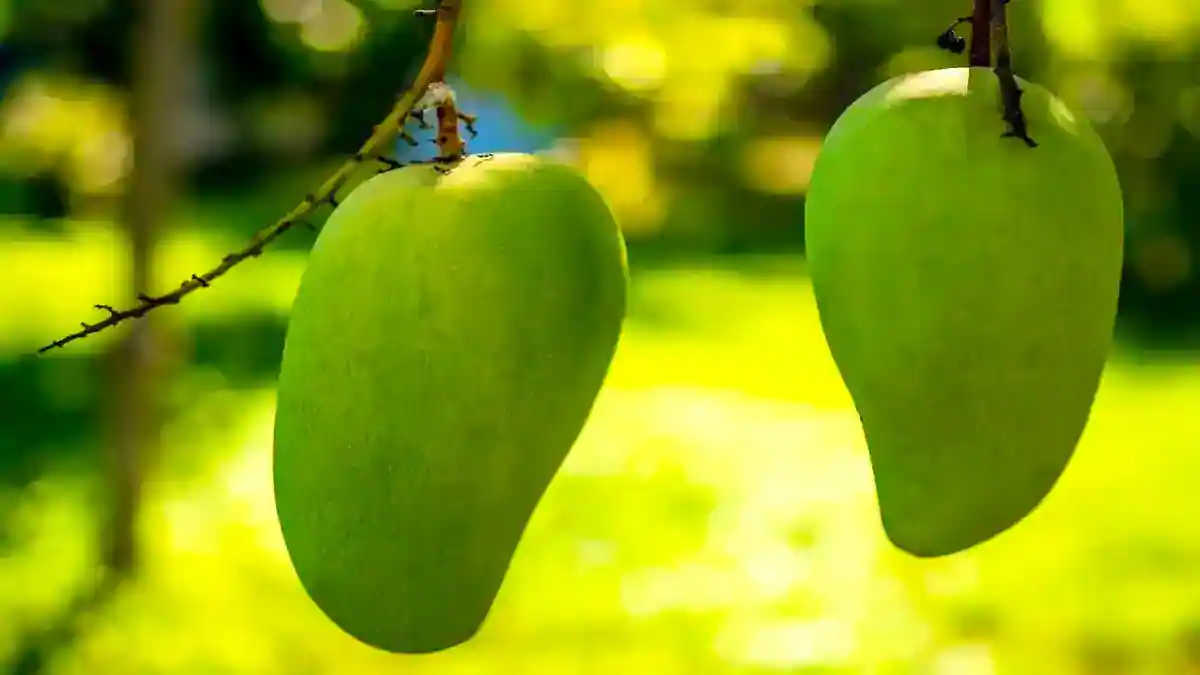
Langra Mango Nutrition
- Calories: 60 kcal
- Carbohydrates: 15 g
- Protein: 0.5 g
- Fat: 0.3 g
- Fiber: 1.6 g
- Vitamin C: 36% of the daily value
- Vitamin A: 9% of the daily value
- Folate: 6% of the daily value
- Potassium: 4% of the daily value
- Calcium: 1% of the daily value
- Iron: 1% of the daily value
6: Anwar Ratol
Anwar Ratol mango is named after Anwar-ul-Haq, who first cultivated it in Rataul, Uttar Pradesh, India. Today, it is primarily grown in Pakistan’s Punjab region and is known for its fiber less flesh and sweet flavor. [8]
This mango is in high demand and is only available twice during the mango season: first from May to June when it is extremely sweet and has a thin skin, and again from July to August when it is more flavorful but less sweet.

Nutritional Value of Anwar Ratol
- Calories: 5%
- Carbohydrates: 5%
- Fiber: 5%
- Vitamin A: 10%
- Vitamin C: 25%
- Folate: 2%
- Potassium: 3%
7: Fajri Mango
Fajri is a medium-sized mango variety that is grown mainly in the Multan region of Pakistan. It has a greenish-yellow skin with a sweet and juicy flesh. [9] Fajri mangoes are usually available from mid-July to mid-August and are often used to make desserts and mango juice.

8: Alphonso Mango
The Alphonso Mango, also known as the Hapus Mango, is the most popular mango variety in India, where it is grown. The fruit is medium-sized, with a bright yellow-orange skin and a sweet, creamy pulp that melts in your mouth. The Alphonso mango is also rich in vitamin C, fiber, and potassium. [10]

Nutritional Value of Alphonso Mango
- Carbohydrates: 94%
- Fiber: 6%
- Fat: 0%
- Protein: 1%
- Vitamin C: 67%
- Vitamin A: 10%
- Calcium: 1%
- Iron: 1%
9: Tommy Atkins Mango
The Tommy Atkins Mango is a large and oblong-shaped fruit with a greenish-yellow skin and a sweet and slightly tart flavor. It is grown in various parts of the world, including the United States, Mexico, and South America. [11] Although it is not as popular as some of the other mango varieties, it is known for its long shelf life, which makes it an excellent choice for exporting.
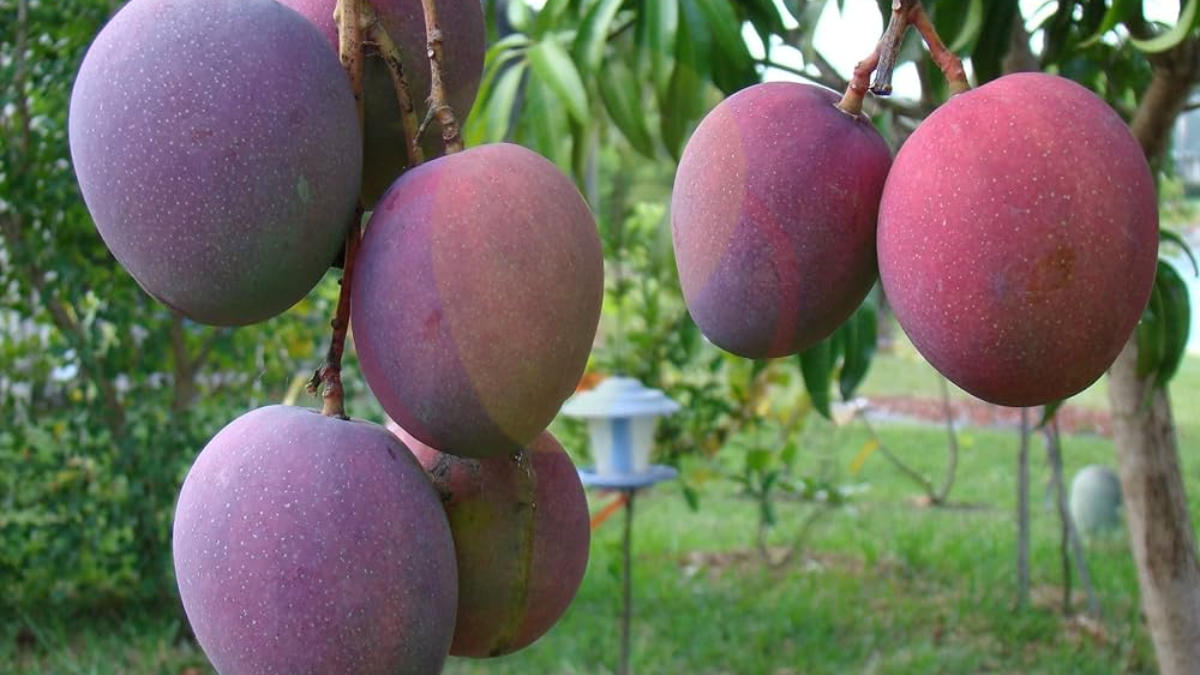
10: Kent Mango
The Kent Mango is a large, oval-shaped fruit with a green-yellow skin and a sweet and juicy flesh. It is grown in various parts of the world, including Florida, Mexico, and Ecuador. The Kent mango is also known for its high fiber content, which makes it an excellent choice for those looking to improve their digestion. [12]
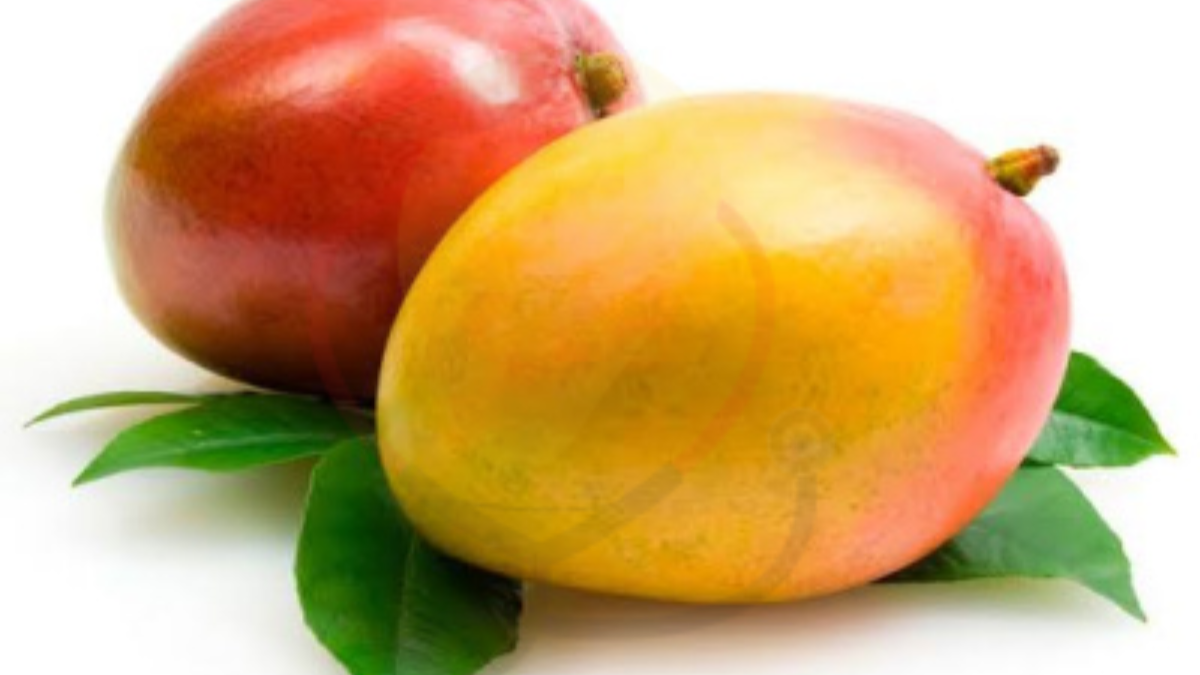
Nutritional Value of Kent Mango
Here are some of the key nutrients found in a 100-gram serving of Kent Mangoes, along with the percentage of the recommended daily value (DV) for each nutrient:
- Calories: 70
- Carbohydrates: 17.0 g (6% DV)
- Fiber: 1.8 g (7% DV)
- Protein: 0.5 g (1% DV)
- Fat: 0.3 g (0% DV)
- Vitamin C: 27.7 mg (31% DV)
- Vitamin A: 765 IU (15% DV)
- Folate: 14 mcg (4% DV)
- Potassium: 156 mg (3% DV)
- Magnesium: 9 mg (2% DV)
11: Ataulfo Mango
The Ataulfo Mango, also known as the Champagne Mango, is a small and oval-shaped fruit with a golden-yellow skin and a sweet and buttery flavor. It is primarily grown in Mexico, but it is also available in other parts of the world. The Ataulfo mango is rich in vitamin C and beta-carotene, which are essential for maintaining healthy skin, eyes, and immune system. [13]

Nutritional Value Ataulfo Mango
- Calories: 60
- Protein: 0.8 grams
- Fat: 0.4 grams
- Carbohydrates: 15 grams
- Fiber: 1.6 grams
- Vitamin A: 10% of the Daily Value (DV)
- Vitamin C: 67% of the DV
- Vitamin E: 4% of the DV
- Vitamin K: 4% of the DV
- Thiamin: 2% of the DV
- Riboflavin: 3% of the DV
- Niacin: 3% of the DV
- Vitamin B6: 5% of the DV
- Folate: 5% of the DV
- Pantothenic acid: 3% of the DV
- Calcium: 1% of the DV
- Iron: 1% of the DV
- Magnesium: 3% of the DV
- Phosphorus: 1% of the DV
- Potassium: 7% of the DV
- Zinc: 1% of the DV
12: Keitt Mango
The Keitt Mango is a large and round-shaped fruit with a green skin that turns yellow when fully ripe. It is grown in various parts of the world, including the United States, Mexico, and Australia. The Keitt mango has a sweet and juicy flesh that is low in fiber, making it an excellent choice for those who prefer a smoother texture. [14]

Nutritional Value of Keitt Mango
- Calories: 4%
- Carbohydrates: 7%
- Fiber: 8%
- Vitamin C: 67%
- Vitamin A: 10%
- Folate: 6%
- Potassium: 4%
13: Honey Mango
The Honey Mango, also known as the Momi K Mango, is a small and round-shaped fruit with a yellow-orange skin and a sweet and honey-like flavor. It is primarily grown in Hawaii, but it is also available in other parts of the world. The Honey mango is rich in vitamin C, potassium, and beta-carotene, making it an excellent choice for maintaining a healthy immune system and promoting good vision. [15]

Nutritional Value of Honey Mango
- Calories: 70
- Protein: 0.5g
- Fat: 0.27g
- Carbohydrates: 17g
- Fiber: 1.8g
- Sugar: 14g
- Vitamin C: 27%
- Vitamin A: 10%
- Folate: 8%
- Potassium: 6%
- Calcium: 1%
- Iron: 1%
14: Palmer Mango
The Palmer Mango is a large and oval-shaped fruit with a greenish-yellow skin and a sweet and juicy flesh. It is primarily grown in Florida, where it is known for its consistent quality and flavor. The Palmer mango is also rich in vitamins A and C, which are essential for maintaining healthy skin and eyesight. [16]

Nutritional Value of Palmer Mango
- Carbohydrates: 97%
- Fiber: 7%
- Protein: 1%
- Fat: 1%
- Vitamin C: 76%
- Vitamin A: 25%
- Folate: 9%
- Potassium: 6%
- Copper: 4%
- Magnesium: 4%
- Vitamin B6: 4%
15: Bombay Green Mango
Bombay Green mangoes come from the central region of India, specifically Bombay and its surrounding areas. Unlike other mango varieties, these mangoes have a green skin even when they are ripe. It can be challenging to determine whether they are ripe based solely on their appearance. [17]
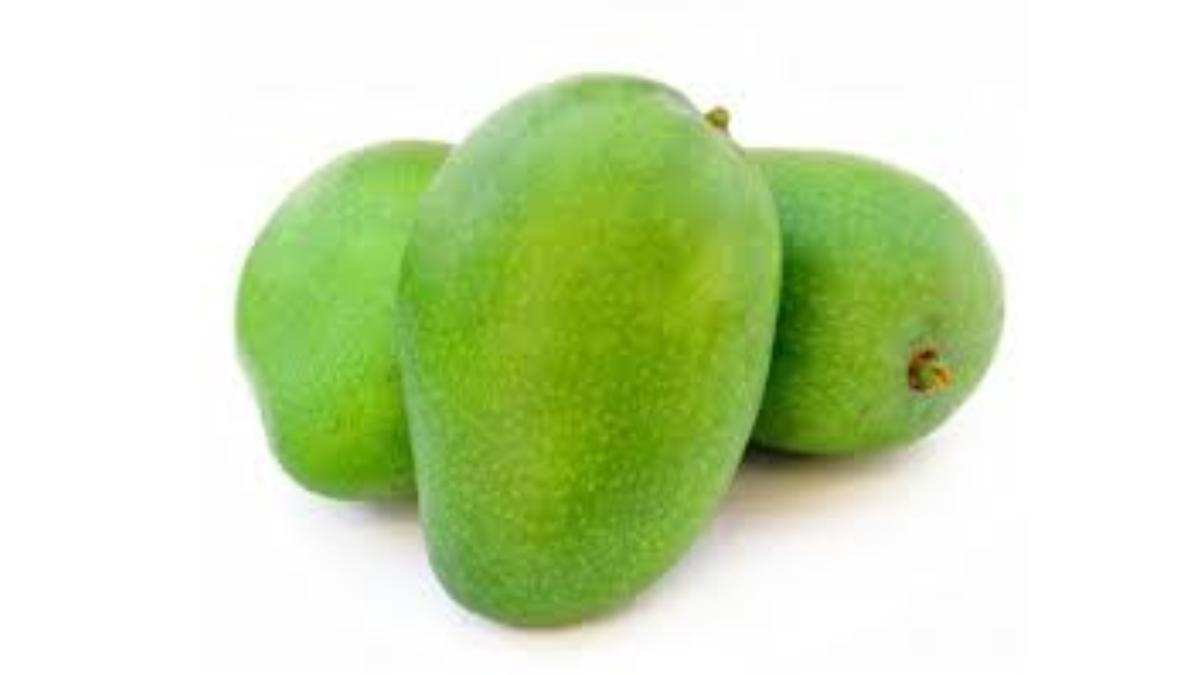
16: Totapuri mango
If you enjoy a balance of sweet and sour flavors, then you might want to try the Totapuri mango. These mangoes have a distinctively tart taste, with a thick skin and a pointed shape. They are mainly grown in South India and western regions like Maharashtra and Gujarat. [18]

Nutritional Value of Totapuri mango
- Calories: 70 kcal
- Carbohydrates: 17.0 g
- Protein: 0.5 g
- Fat: 0.3 g
- Fiber: 1.8 g
- Vitamin C: 27.7 mg (46% of daily value)
- Vitamin A: 1262 IU (25% of daily value)
- Vitamin E: 1.12 mg (6% of daily value)
- Vitamin K: 4.2 mcg (5% of daily value)
- Potassium: 156 mg (4% of daily value)
- Magnesium: 10 mg (3% of daily value)
- Calcium: 10 mg (1% of daily value)
17: Valencia Pride mango
Valencia Pride is a type of mango that is known for its large size and vibrant yellow skin. It is typically grown in Florida, USA and is in season during the summer months. The flesh of the Valencia Pride mango is soft and juicy, with a sweet and tangy taste. It is often used in smoothies, salads, or as a topping for desserts like ice cream. [19] This mango variety is also popular for its long shelf life and ability to be shipped long distances without spoiling.
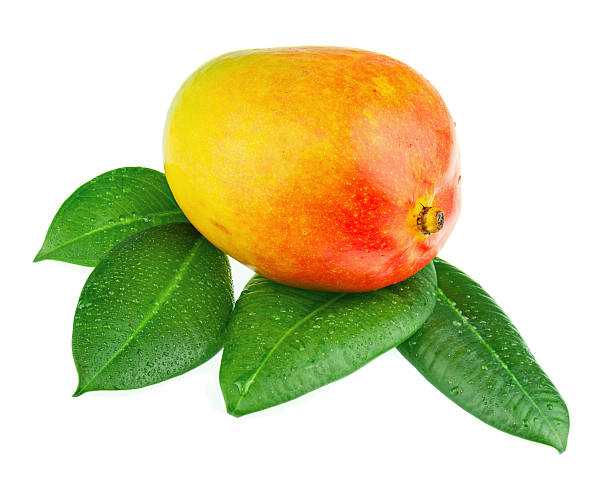
Nutritional Value of Valencia Pride mango
- Calories: 65 kcal (3%)
- Carbohydrates: 17 g (5%)
- Fiber: 1.8 g (7%)
- Sugars: 14 g
- Protein: 0.5 g (1%)
- Fat: 0.3 g (<1%)
- Vitamin C: 60.1 mg (67%)
- Vitamin A: 1082 IU (36%)
- Folate: 14 μg (3.5%)
- Potassium: 156 mg (3.3%)
18: Hapus Mango
Hapus mango, also known as Alphonso mango, is a popular mango variety originating from the western region of India. It is known for its rich, creamy, and sweet flavor, along with its bright orange-yellow flesh and thin, delicate skin. Hapus mangoes are highly sought after and considered a premium variety due to their short harvesting season, which typically runs from April to June. They are commonly used in a variety of culinary applications, including desserts, smoothies, and even in savory dishes. [20]
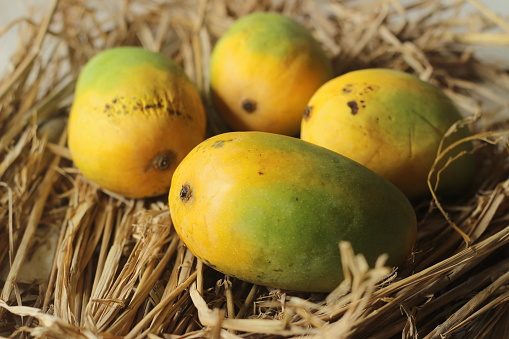
Nutritional Value of Hapus Mango
- Calories: 60
- Carbohydrates: 15 g
- Fiber: 1.2 g
- Protein: 0.8 g
- Fat: 0.4 g
- Vitamin C: 36% of the Daily Value (DV)
- Vitamin A: 14% of the DV
- Potassium: 6% of the DV
- Calcium: 1% of the DV
- Iron: 1% of the DV
19: Raspuri Mango
Raspuri is a type of mango that is mainly grown in the Indian state of Karnataka. It is small to medium in size with a thin skin that is yellow in colour with a slight red blush. [21] The flesh of the fruit is fibreless, juicy, and has a sweet aroma. It is a popular variety of mango, known for its rich flavour and delicate texture, and is often used to make juices, smoothies, and desserts. The Raspuri season begins in May and lasts until July.
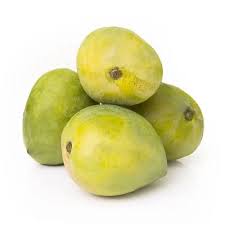
Nutritional Value of Raspuri Mango
- Calories: 65 kcal
- Carbohydrates: 17.7 g
- Protein: 0.5 g
- Fat: 0.27 g
- Fiber: 1.8 g
- Vitamin A: 21%
- Vitamin C: 60%
- Calcium: 1%
- Iron: 1%
20: Pairi Mango
Pairi mango is a type of mango that is primarily grown in Gujarat, India. It is a small to medium-sized mango with a round shape and a greenish-yellow skin. The flesh is sweet and aromatic, with a smooth texture and a small seed in the center. Pairi mangoes are known for their early maturation and are usually available in the market from May to June. They are a popular choice for making mango juice, as well as for using in desserts and other sweet dishes. [22]
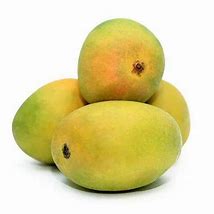
Nutritional Value of Pairi Mango
- Calories: 60
- Carbohydrates: 15 g
- Protein: 0.5 g
- Fat: 0.27 g
- Fiber: 1.6 g
- Vitamin C: 36%
- Vitamin A: 10%
- Folate: 5%
- Potassium: 3%
- Calcium: 1%
21: Himsagar Mango
Himsagar Mango is a popular variety of mango that is grown mainly in the state of West Bengal, India. It is a medium-sized mango with a yellowish-green skin and a sweet, juicy flesh. Himsagar mangoes are known for their distinct aroma and flavour, and are often considered one of the best-tasting mangoes in India. They are typically available from mid-June to mid-July, and are used in a variety of dishes including desserts, jams, and chutneys. [23]
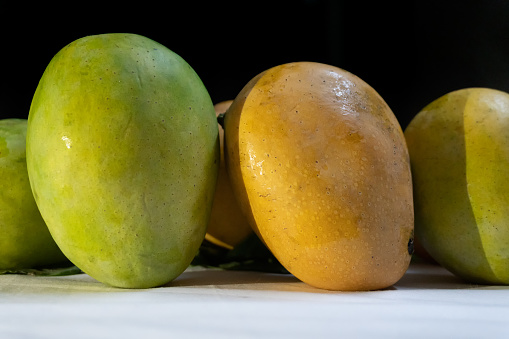
Nutritional Value of Himsagar Mango
- Energy: 60 kcal
- Carbohydrates: 15 g
- Protein: 0.5 g
- Fat: 0.3 g
- Fiber: 1.5 g
- Vitamin C: 27 mg (45% of Daily Value)
- Vitamin A: 765 IU (15% of Daily Value)
- Potassium: 170 mg (5% of Daily Value)
22: Malgova Mango
Malgova mango is a type of mango that is predominantly grown in Tamil Nadu, India. It is known for its large size, oval shape, and green-yellow skin with red spots. The flesh is juicy, fiberless, and has a sweet and aromatic flavor with a hint of tartness. Malgova mangoes are typically available from June to August and are often used in traditional Indian desserts like mango lassi, mango pudding, and mango ice cream. [24]

Nutritional Value of Malgova Mango
- Calories: 67%
- Carbohydrates: 95%
- Protein: 2%
- Fat: 1%
- Fiber: 6%
- Vitamin C: 80%
- Vitamin A: 21%
- Calcium: 1%
- Iron: 1%
23: Malda Mango
Malda Mango is a popular variety of mango that is grown in the Malda district of West Bengal, India. It is medium-sized, oblong-shaped, and has a greenish-yellow skin when it is unripe. [25] Once it ripens, the skin turns yellow with reddish spots. The flesh of Malda Mango is juicy and has a sweet, aromatic flavor. It is typically harvested in June and July, and is a favorite among mango lovers in India.
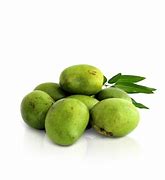
24: Badami Mangoes
Badami mangoes, also known as Alphonso’s cousin, are a popular type of mango in India. They are smaller in size compared to other mango varieties and have a distinctively sweet and creamy flavor with a mild tartness. The skin of Badami mangoes is usually bright yellow with a reddish tinge and thin, making it easy to peel. They are grown primarily in the southern state of Karnataka and are available from April to June. [26]

Nutritional Value of Badami Mangoes
- Calories: 70
- Carbohydrates: 17.7 g
- Protein: 0.5 g
- Fat: 0.27 g
- Fiber: 1.8 g
- Vitamin C: 36.4 mg (60% DV*)
- Vitamin A: 765 IU (15% DV)
- Calcium: 10 mg (1% DV)
- Iron: 0.13 mg (1% DV)
25: Safeda Mangoes
Safeda mangoes, also known as Banganapalli mangoes, are a popular variety of mangoes that originated in the town of Banganapalle in Andhra Pradesh, India. They are large in size, with an oblong shape and a golden-yellow skin when fully ripe. [27]
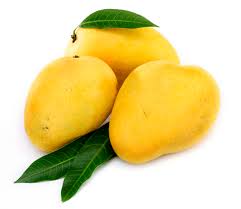
Nutritional Value of Safeda Mangoes
- Calories: 67%
- Carbohydrates: 84%
- Fiber: 16%
- Protein: 4%
- Fat: 1%
- Vitamin C: 60%
- Vitamin A: 10%
- Calcium: 1%
- Iron: 1%
26: Lakshmanbhog Mangoes
Lakshmanbhog mangoes are a popular variety of mango that is primarily grown in the state of West Bengal, India. They are named after the Hindu god, Lakshman, and are known for their small size and oval shape. The skin of the mango is greenish-yellow in color with a slight red blush, and the flesh is juicy and aromatic with a sweet, delicate flavor. [28]
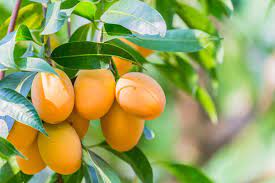
Nutritional Value of Lakshmanbhog Mangoes
Here is the nutritional value of Lakshmanbhog Mango per 100 grams:
- Calories: 65
- Carbohydrates: 17.0g
- Protein: 0.5g
- Fat: 0.27g
- Fiber: 1.8g
- Vitamin C: 27.7mg (46% of the recommended daily intake)
- Vitamin A: 765 IU (15% of the recommended daily intake)
- Calcium: 11mg
- Iron: 0.16mg
- Potassium: 156mg
27: Amrapali Mangoes
Amrapali mangoes are a hybrid variety of mangoes, developed in India in 1971. It is a cross between the Dasheri and Neelam mango varieties. These mangoes are oval-shaped, medium-sized, and have a bright orange skin when ripe. They have a sweet aroma and the flesh is juicy, fibreless and has a rich, sweet flavor. Amrapali mangoes are mostly grown in the states of Uttar Pradesh, Bihar, and West Bengal in India. They are available in the market from June to July. [29]

Nutritional Value of Amrapali Mangoes
- Calories: 60%
- Carbohydrates: 63%
- Fiber: 17%
- Vitamin C: 50%
- Vitamin A: 15%
- Folate: 8%
- Potassium: 6%
- Copper: 4%
- Calcium: 2%
- Iron: 2%
28: Imam Pasand Mangoes
Imam Pasand Mangoes, also known as Himayat or King of Mangoes, are a premium mango variety mainly grown in Andhra Pradesh, India. The mangoes are large in size, with a unique oblong shape and a golden yellow skin when ripe. [30] The flesh is sweet, juicy, and fiberless, with a distinct aroma and flavor. These mangoes are highly sought after and often regarded as one of the best-tasting mangoes in the world.
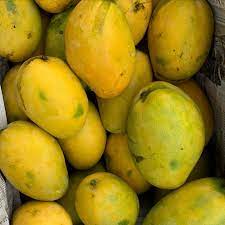
Nutritional Value of Imam Pasand Mangoes
Here are the approximate nutritional values of a 100-gram serving of Imam Pasand mango:
- Calories: 70
- Carbohydrates: 17.0 g
- Fiber: 1.8 g
- Protein: 0.5 g
- Fat: 0.27 g
- Vitamin C: 27% of the Daily Value (DV)
- Vitamin A: 10% of the DV
- Vitamin B6: 5% of the DV
- Potassium: 3% of the DV
- Magnesium: 2% of the DV
29: Fazli Mangoes
Fazli mangoes are a type of mango that is primarily grown in the Malda district of West Bengal, India. It is a large-sized mango with a thin skin and a juicy, fiberless pulp. Fazli mangoes are known for their unique aroma and are usually available from June to August. They are commonly used in desserts, pickles, and chutneys. [31]
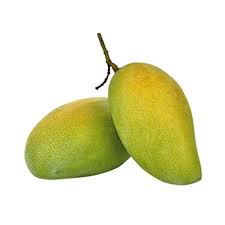
Nutritional Value of Fazli Mangoes
Here are the approximate nutritional values of Fazli Mango per 100 grams:
- Calories: 70
- Carbohydrates: 17.1 g
- Fiber: 1.8 g
- Protein: 0.5 g
- Fat: 0.27 g
- Vitamin A: 10%
- Vitamin C: 60%
- Calcium: 1%
- Iron: 1%
30: Mankurad Mangoes
Mankurad Mangoes are a popular variety of mangoes grown in the coastal regions of Maharashtra, India. They are medium to large-sized, oval-shaped mangoes with a yellowish-green skin when ripe. The flesh is juicy, fiberless, and has a sweet aroma with a tangy taste. Mankurad mangoes are usually available during the peak season from June to July and are highly prized for their delicious taste and aroma. [32]
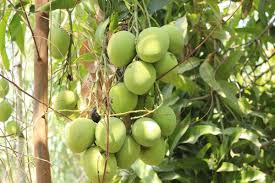
Nutritional Value of Mankurad Mangoes
Here is the approximate nutritional value of Mankurad Mango per 100 grams of edible portion:
- Energy: 70 kcal
- Carbohydrates: 17.0 g
- Fiber: 1.8 g
- Protein: 0.5 g
- Fat: 0.3 g
- Vitamin A: 10%
- Vitamin C: 60%
- Calcium: 1%
- Iron: 1%
- Potassium: 3%
31: Mallika Mangoes
Mallika mangoes are a hybrid variety of mangoes that were created in India through cross-breeding of the varieties Neelam, Dashehari, and Dasheri. They are small to medium-sized mangoes with a yellow-orange skin and a sweet, aromatic flesh with a pleasing texture. The Mallika mango is known for its high sweetness, juicy pulp, and long shelf life. [33]
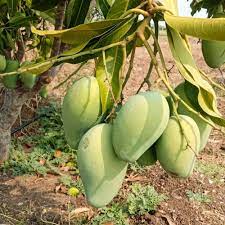
Nutritional Value of Mallika Mangoes
Malika mangoes provide the following nutrients in percentages based on a 100-gram serving:
- Energy: 70 kcal
- Carbohydrates: 17.2 g
- Protein: 0.5 g
- Fat: 0.27 g
- Fiber: 1.8 g
- Vitamin C: 27.7 mg (46% of daily value)
- Vitamin A: 1082 IU (22% of daily value)
- Folate: 14 µg (3.5% of daily value)
- Potassium: 156 mg (4.4% of daily value)
32: Gulab Khaas Mangoes
Gulab Khaas mangoes are a type of mango that are known for their distinct aroma and sweet, juicy flesh. They are primarily grown in the Northern regions of India and are usually available during the peak mango season from May to August. [34]
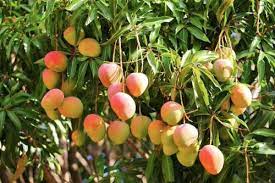
33: Vanraj Mangoes
Vanraj mangoes are a popular variety of mangoes that are grown in Gujarat, a western state of India. They are known for their bright yellow skin and sweet flavor. The fruit is medium-sized and has a firm texture with a small seed. Vanraj mangoes are usually available from May to July, and are used in various dishes, such as salads, smoothies, and desserts. [35]
The high fiber content in Gulab Khaas Mangoes helps improve digestion and promotes bowel regularity. The antioxidants present in these mangoes help protect the body against cellular damage caused by free radicals, reducing the risk of chronic diseases such as cancer and heart disease.
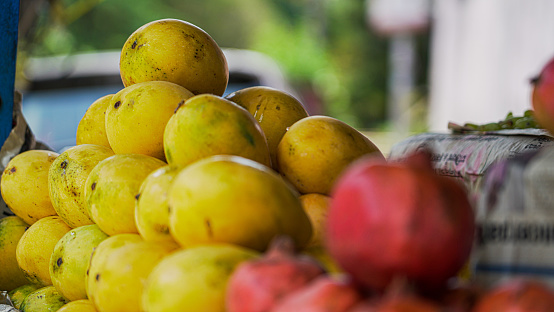
34: Kilichundan Mango
Kilichundan Mango is a popular variety of mango grown in the Indian state of Kerala. It is a small-sized mango, usually round or oval-shaped, and has a distinct sweet and sour taste. The skin of the mango is bright yellow with green overtones, and the flesh is juicy and fibreless. [36]
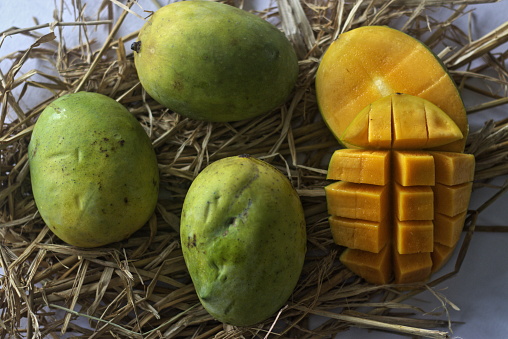
Kilichundan Mango Nutrition
A 100-gram serving of raw mango contains:
- Calories: 60
- Carbohydrates: 15 grams
- Protein: 0.8 grams
- Fat: 0.4 grams
- Fiber: 1.6 grams
- Vitamin C: 36% of the Daily Value (DV)
- Vitamin A: 10% of the DV
- Folate: 9% of the DV
Mangoes are undoubtedly one of the most delicious and nutritious fruits in the world with many health benefits and nutritional values. With so many varieties available, it can be challenging to choose just one. Each mango variety has its unique flavor, texture, and aroma, making it a delightful experience to try them all.
FAQs
How many types of mangoes are there?
There are hundreds of varieties of mangoes, but some of the most commonly known types are Alphonso, Ataulfo, Haden, Kent, Manila, and Tommy Atkins.
What is the difference between different types of mangoes?
Different types of mangoes have varying sizes, shapes, colors, flavors, textures, and ripening times. For example, Alphonso mangoes are small, yellow, and very sweet, while Tommy Atkins mangoes are large, green, and slightly tart.
What is the best type of mango?
The best type of mango is subjective and depends on personal taste preferences. Some people prefer sweet and juicy mangoes like Alphonso or Ataulfo, while others like tangy and firm mangoes like Tommy Atkins.
What is the most expensive type of mango?
The Alphonso mango, also known as the King of Mangoes, is often considered the most expensive type of mango due to its short season and high demand.
Are all types of mangoes available year-round?
No, different types of mangoes have different ripening times and are typically available during certain seasons. For example, Ataulfo mangoes are usually available from March to July, while Haden mangoes are typically available from April to June.
Can different types of mangoes be used interchangeably in recipes?
It depends on the recipe and the desired flavor and texture. Some recipes may call for a specific type of mango, while others may allow for substitutions. It’s best to consult the recipe or experiment with different types of mangoes to find what works best for the desired outcome.

